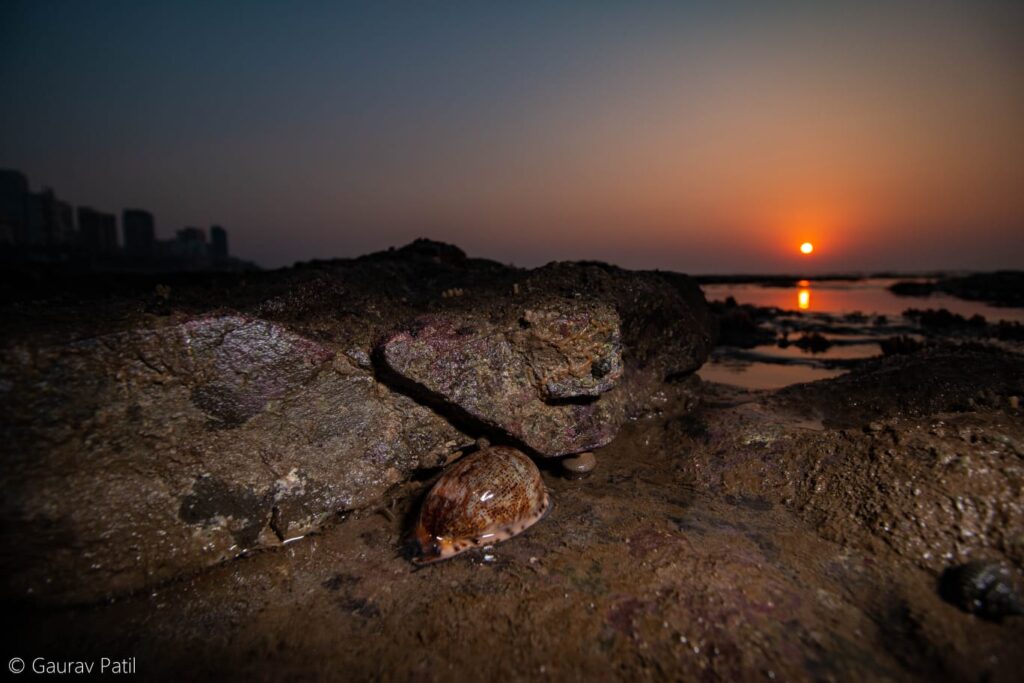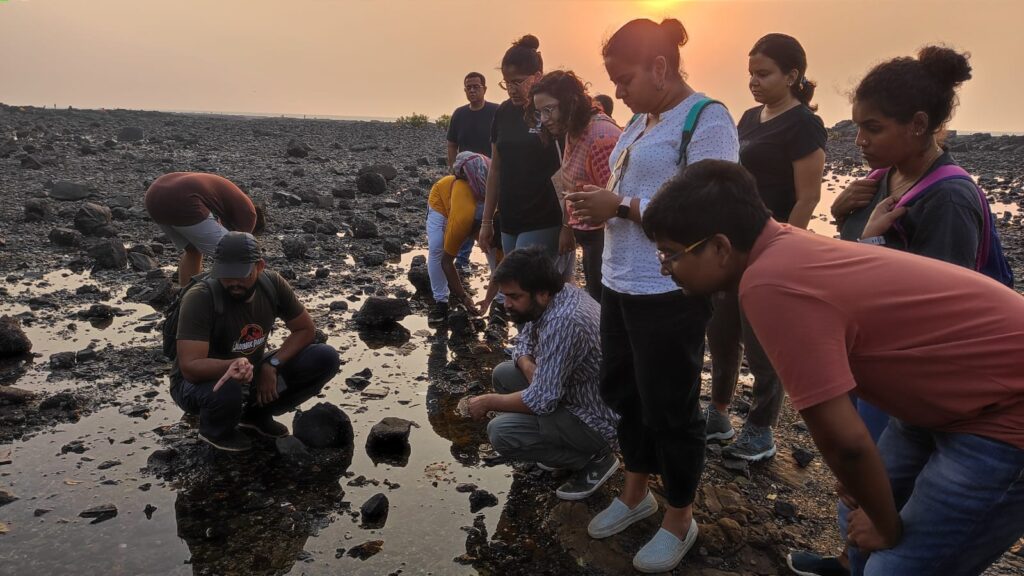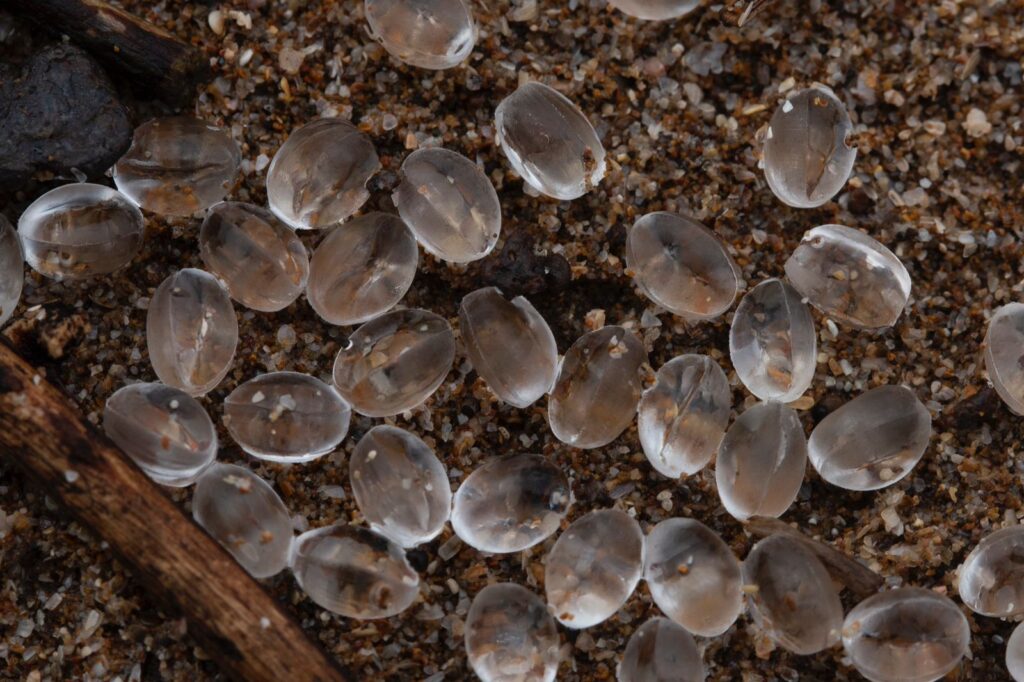In its earlier avatar, Mumbai was known as ‘Heptanesia’, denoting a collective of seven islands, as named by Ptolemy in 150 AD. With the city being transformed from a cluster of islands into a unified mass in early 18th century, its enduring connection to the coastline beholds captivating marine biodiversity that lies right at our doorstep.
There exists a facet of Mumbai that remains shadowed within the towering buildings and lost between the burgeoning crowds. Often hailed as a ‘city that never sleeps’, it also holds a hidden truth: its shores too remain in a perpetual state of wakefulness.
The project ‘Marine Life of Mumbai’ (MLOM) was incepted in 2017 to unveil this hidden and once forgotten marine realm called the intertidal zone on the shores of Mumbai. By shedding light on the seam between Mumbai’s urban fabric and its marine inhabitants, this initiative serves as a reminder that even amidst the clamour of city life, a vibrant and delicate marine ecosystem continues to thrive, bearing witness to the city’s multifaceted identity.
Hidden wonders of the coast
Through MLOM, its primary outreach project , CCF conducts shore walks, which is a guided walk organised on the very shores of the city. It is timed strategically to coincide with the spring low tides, a period when the water retreats to its nadir, revealing the hidden wonders. This window typically lasts not more than two hours and is regarded as optimal for encountering marine creatures in their natural habitat. The saying that time and tide waits for none holds true, if you miss this tide, you miss the opportunity!

The shore walks offer more than just a glimpse. The walk commences with downward gazes looking for creatures or their traces on a sandy beach or goes on flipping rocks on rocky shores to find sea stars, sea anemones, octopus, sea urchins, fiddler crabs and many more crabs, sea snails, corals, decorator worms, sea slugs, moray eels and the list goes on. Yet, they appear as if they are on a quest for something lost.
But it turns out to be a search for the forgotten and ignored inhabitants of the coasts of Mumbai. These creatures have never been lost, they have thrived here parallelly with Mumbai’s urbanisation, hidden from casual glances.
Participants stand awestruck as they realise that what seemed to be an inanimate coast is, in fact, brimming with life as far as their eyes can see. They transform from mere spectators to engaged explorers, the participants bridge the gap between ignorance and understanding, and the coast is no more conceived just as a sandy, rocky or a muddy stretch but a thriving ecosystem.
Training participants to be citizen scientists
The primary objective of MLOM is to raise awareness and actively engage the residents of the city using the approach of citizen science. This approach seeks to harness the collective power of ordinary citizens, transforming them into active participants in scientific endeavours. Rather than being passive recipients of information, they become integral contributors to the accumulation of knowledge and the pursuit of solutions to pressing challenges. It encourages individuals to gather data, share observations, and collaborate with subject experts, blurring the lines between professional scientific community and the general public.
The participants of the shore walks are encouraged to click pictures of the creatures that they see on the walk and upload it on a citizen science based free platform ‘iNaturalist’ and add it to ‘Marine life of Mumbai’ project that functions as an open and online repository of such observations which is then used as preliminary data in scientific research.

In essence, through the medium of citizen science it tries to forge a relationship between scientific exploration, public engagement, and urban living, leading to a more informed and environmentally conscious community.
Through it, the city’s human inhabitants additionally gain an immersive understanding of pressing environmental concerns that often remain ignored and how they may have a detrimental effect on the city’s marine inhabitants .
Issues such as littering, irresponsible plastic usage and disposal, the unchecked flow of untreated sewage into the seas, and the haphazard construction of coastal infrastructure come to the forefront. The significance of the need to keep our coasts clean becomes vividly evident.
Participants, as they sift through discarded debris, become witnesses to the detrimental impact of human negligence on the very ecosystems that sustain us. They witness firsthand the harm that the improper disposal of single-use plastics and non-biodegradable materials inflict upon marine life and habitats.
Read More: City Nature Challenge: Exploring neighbourhoods for citizen science
A tragedy on Mumbai’s coast
The recent issue being that of the massive quantities of plastic nurdles that washed ashore on the beaches of Mumbai has ignited significant concerns and highlighted the far-reaching consequences of plastic pollution. Nurdles are tiny, pre-production pellets, measuring less than 5mm and serve as the raw material for manufacturing plastic products. These pellets either sink or float depending on their density and if they are present in freshwater or saltwater.
It was the night of 1st January, 2019 that nurdles were proved to be a ‘maritime disaster’, when a container ship MSC Zoe lost 300 containers in the Northern Wadden Sea, some of which were filled with nurdles. The executive arm of the Dutch Ministry of Infrastructure and the Environment figured that this calamitous ship had also released 10,000 kilos of polystyrene nurdles which are denser and sink to the bottom as compared to the 600 kilos of polyethylene nurdles that floated and washed ashore on the beaches sometime later. From this consequential night of 2019 to the most recent reported incident of X-PressPearl off Sri Lanka’s coast in November 2021, such incidents and their repercussions have increased in numerous folds.

The sudden arrival of these nurdles on Mumbai’s beaches from unknown sources, underscores the complexity of plastic pollution and the challenges associated with its tracking origins. Moreover, it is impractical to clean them off the beach or scoop the floating ones from the water columns. The presence of these nurdles on the city’s beaches is alarming for several reasons as they are often mistaken for food by birds and animals, leading to its ingestion.
Nurdles are classified as microplastics and under the influence of UV light, wind, waves and other natural elements disintegrate into even smaller bits becoming nanoplastics, and further breakdown into microscopic pieces that can be eaten by the microscopic animals that are at the bottom of the food chain and consequently escalating up the food chain. They further degrade the ecosystem by mixing with the sand and interfere with natural processes of sand and sediment movement, affecting the nesting grounds of marine animals and feeding habits of coastal birds.
The nurdles are inexpensive, hence the manufacturers behave irresponsibly towards its production and transport. Additionally, they are not regarded as hazardous by the International Maritime Organisation despite the resultant menace it has caused in the past incidents. This incident can hopefully galvanise greater awareness and action towards protecting marine ecosystems.